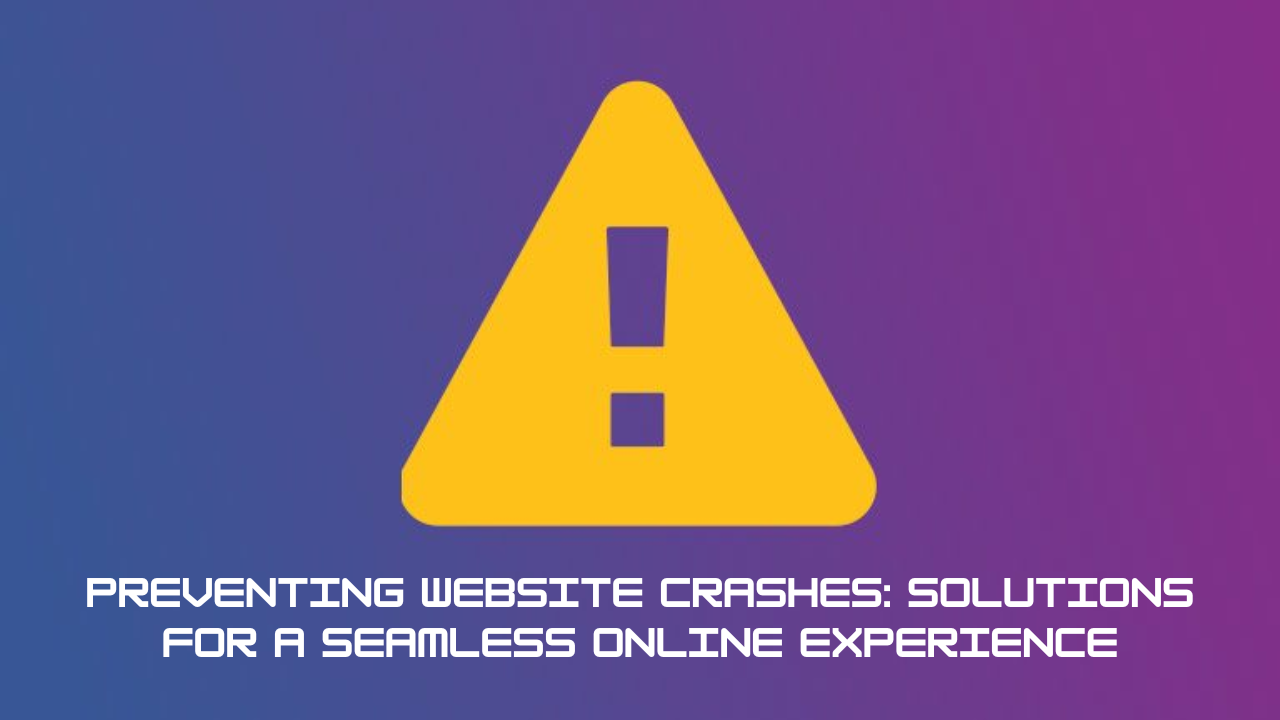Preventing Website Crashes: Solutions for a Seamless Online Experience
 Aakashi Jaiswal
Aakashi Jaiswal
Website crashes can be a significant headache for both website owners and users. When a website goes down, it can lead to lost revenue, damaged reputation, and frustrated visitors. Understanding the reasons for these crashes and how to resolve them is crucial for maintaining a reliable online presence. In this blog post, we'll explore the common causes of website crashes and provide detailed solutions to prevent and fix them.
Common Reasons for Website Crashes
- High Traffic Volume
One of the most frequent causes of website crashes is an unexpected surge in traffic. This can happen during promotional events, product launches, or viral content sharing. If the server cannot handle the increased number of requests, it may become overwhelmed, leading to downtime.
- Broken Code
Websites are built using code, and even minor errors can lead to significant issues. Broken code can occur due to recent changes made by developers or outdated scripts that are no longer compatible with newer systems. Syntax errors, missing brackets, or incorrect function calls can all contribute to a crash.
- Plugin Conflicts
Many websites use plugins to enhance functionality. However, incompatible or outdated plugins can cause conflicts that lead to crashes. If a plugin is not properly maintained or updated, it may not work well with other components of the website.
-Server Issues

The reliability of your hosting provider plays a critical role in your website's performance. Shared hosting environments often struggle under high traffic loads because resources are divided among multiple sites. Additionally, server misconfigurations or hardware failures can lead to crashes.
-Database Overload
Websites that rely heavily on databases may experience crashes if the database becomes overloaded with queries. This is particularly common during traffic spikes when many users are trying to access data simultaneously.
-DDoS Attacks
Distributed Denial of Service (DDoS) attacks involve overwhelming a server with traffic from multiple sources, effectively taking it offline. These attacks can be devastating for businesses that rely on their websites for revenue and customer engagement.
-Lack of Maintenance
Websites require regular maintenance to function correctly. Failing to update software, plugins, and security protocols can leave a site vulnerable to crashes due to bugs or security breaches.
-Bandwidth Limitations
Every hosting plan comes with a certain amount of bandwidth allocated for data transfer. If your site exceeds this limit due to high traffic or large media files, it may slow down significantly or crash altogether.
How to Solve Website Crashes
-Monitor Traffic and Performance
Using tools like Google Analytics or server monitoring software can help you track traffic patterns and identify potential issues before they escalate into crashes. Set up alerts for unusual spikes in traffic so you can prepare accordingly.
-Optimize Code
Regularly review your website's code for errors and inefficiencies. Use debugging tools to identify problematic areas and ensure that all code adheres to best practices. Consider using a staging environment for testing changes before deploying them live.
-Update Plugins and Themes
Keep all plugins and themes up-to-date to avoid compatibility issues that could lead to crashes. Regular updates often include bug fixes and performance improvements that enhance overall site stability.
-Choose the Right Hosting Plan
Select a hosting provider that offers scalable solutions tailored to your needs. If you anticipate high traffic volumes, consider cloud hosting or dedicated servers that provide more resources than shared hosting plans.
-Implement Load Balancing
Load balancing distributes incoming traffic across multiple servers, preventing any single server from becoming overwhelmed. This strategy is especially useful during peak traffic periods.
-Use Content Delivery Networks (CDNs)
CDNs help distribute content across various geographical locations, reducing the load on your main server and improving load times for users worldwide. This can significantly decrease the chances of crashing during high traffic periods.
-Regular Backups
Implement automated backup solutions that regularly save your website's data and configurations. In case of a crash, you can quickly restore your site without losing significant data.
-Conduct Load Testing
Before launching new features or promotions, conduct load testing to simulate high traffic conditions on your site. This will help you identify potential bottlenecks and optimize performance accordingly.
-Enhance Security Measures
Protect your website from DDoS attacks by using security services that monitor incoming traffic patterns and block suspicious activity before it reaches your server.
-Communicate with Users
If your website does go down, keep users informed about the situation through social media or email updates. Transparency helps maintain trust even during technical difficulties.
Steps to Take When Your Website Crashes
If your website does crash despite preventive measures, follow these steps:
Verify the Crash: Ensure that the issue is not local (e.g., browser cache problems) by checking from different devices or using online status checkers.
Identify the Cause: Check server logs for error messages or unusual activity that could indicate what caused the crash.
Contact Your Hosting Provider: If you're unable to diagnose the problem yourself, reach out to your hosting provider's support team for assistance.
Implement Temporary Solutions: Consider redirecting users to a temporary landing page or a virtual waiting room while you resolve the issue.
Restore from Backup: If necessary, restore your site from a recent backup if you cannot resolve the issue quickly.
Communicate Updates: Keep users informed about progress in restoring service and expected timelines for resolution.
Conclusion
Website crashes are an unfortunate reality of managing an online presence but understanding their causes and implementing preventive measures can significantly reduce their occurrence and impact. By monitoring performance, optimizing code, choosing reliable hosting solutions, and maintaining effective communication with users, you can create a stable online environment that minimizes downtime and enhances user experience.
Regular maintenance and proactive strategies will not only help prevent crashes but also build trust with your audience as they see your commitment to providing a seamless online experience.
Subscribe to my newsletter
Read articles from Aakashi Jaiswal directly inside your inbox. Subscribe to the newsletter, and don't miss out.
Written by

Aakashi Jaiswal
Aakashi Jaiswal
Coder | Winter of Blockchain 2024❄️ | Web-Developer | App-Developer | UI/UX | DSA | GSSoc 2024| Freelancer | Building a Startup | Helping People learn Technology | Dancer | MERN stack developer